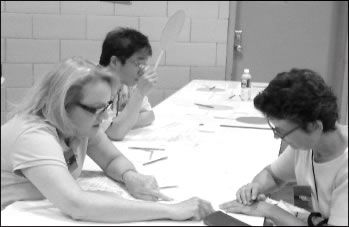By Bonnie Rosenstock
Sat., Aug. 15, was the Day of the POD on the Lower East Side. Around 500 New Yorkers volunteered to enact an all-too-scary scenario. The Office of Emergency Management and the Department of Health and Mental Hygiene teamed up to sponsor the Point of Dispensing Emergency Response Exercise, or POD, for short — which took place at the Marte Valle Secondary School, at 145 Stanton St.
On this blazing hot, 88-degree day, with an enormous silver tent sheltering, but marginally cooling, the schoolyard, the volunteers signed in and were given green ACTOR tags and cold beverages and snacks, while they waited.
The city’s great cross-section of all ages, backgrounds and boroughs came together, either through word of mouth or e-mails from volunteer organizations, like New York Cares or the Red Cross. Joe, 35, a Latino Lower East Sider, married with children, responded to an e-mail from the Department of Health, his employer. He doesn’t know if he would be compensated by the agency, but it doesn’t matter, he said.
“I decided to volunteer in order to be prepared for the future and to be part of the good,” to which Niji, originally from Nigeria, now from Jamaica, Queens, the mother of four kids and also a D.O.H. employee, agreed.
The scenario, according to the handout that volunteers were encouraged to download from the D.O.H. Web site, was that the participants had been alerted by the media and city officials that there had been a widespread airborne anthrax release across the city. Anthrax inhalation may cause fever, coughing, malaise, fatigue, myalgias (muscle pains), profound sweats and chest discomfort, and if not treated quickly, death.
Morgan Johnson, a D.O.H. staffer, explained that in a real-world emergency they would have used the word “Code,” and there would be 200 POD’s citywide for the rapid distribution of medication, but no liquids or food would be available. This exercise would last about two hours, and participants would be cycled through the school three times to enact three different scenarios.
Another staff person said nothing on this scale had ever been done before, although the agency has routine mini-exercises every month. Observers from other city agencies, other regions of the country and from abroad were also present.
To receive medication at POD’s, people have to complete a simple screening form, available electronically or at the POD itself. As the volunteers slowly filed into the school building, they handed in a survey in which they indicated if they understood the instructions to follow in a public health emergency. Inside, signs in more than a dozen languages declared that this was the dispensary site.
Staff directed volunteers to the screening station, a series of long tables where workers held up large green paper circles mounted on what looked like tongue depressors or ice cream bar sticks, to signal they were free to review the screening form. If there were no medical issues, the volunteer moved directly to the dispensing station to receive one or several anthrax drugs, like doxycyclin or ciprofloxacin.
Staff asked for volunteers to act out specific scenarios, like a mother who had gotten separated from a child, or an undocumented foreigner who did not speak English and was frightened by the police presence and masses of people. In the latter case, a worker held aloft a red circle, which summoned a “translator” to take the person through all the steps.
A few days later, participants received an e-mail expressing the city’s thanks. The communiqué also said the agency had identified several areas in the response plans that would need to be enhanced and would “ultimately result in more medication being provided to more New Yorkers in a shorter period of time.”
































